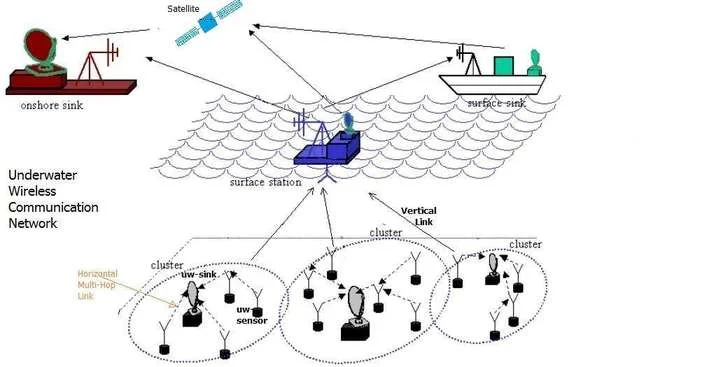Underwater Wireless Communication System
As we know ocean exploration is very essential for following factors.
• To monitor Environment (Climate, pollusion, oil and gas fields, to predict natural disasters)
• Underwater exploration (discovery of resources, deep sea archaelogy )
• Scientific data collection (marine bilogy, oceanography)
• Search and survey to detect the objects in the ocean using imaging/mapping techniques
It is possible for radio frequency waves to propagate longer distances through sea water at very low frequencies(30 to 300 Hz). But this requires larger antenna and higher transmit power. This is not feasible. Moreover very high attenuation occurs using RF wave propagation technique in the ocean.
Optical waves are also affected by scattering losses. Moreover they can be used for shorter distances in the ocean.
As underwater wireless communication is not feasible using radio frequency(RF) and optical light based communication systems, it is carried out using acoustic waves.
As mentioned in the table-1 below, underwater acoustic communication links are classified based on range. Table mentions bandwidths used for different ranges in this type of communication. Acoustic links used in underwater communication systems are of two types viz. vertical and horizontal. This is based on direction of the sound ray. Acoustic frequencies from 10Hz to 1MHz are used in underwater communication.
| Link Type | Range in Km | Bandwidth in KHz |
|---|---|---|
| Very Long | 1000 | <1 |
| Long | 10 to 100 | 2 to 5 |
| Medium | 1 to 10 | ~ 10 |
| Short | 0.1 to 1 | 20 to 50 |
| Very Short | <0.1 | >100 |
Table-1: Underwater acoustic communication range and bandwidth
There are two network topologies which can be used for underwater communication system viz. centralized and decentralized. In centralized architecture all the nodes(i.e. underwater(uw) sink) communicate using a central station(onshore sink or surface sink/station). Centralized architecture is very similar to cellular network architecture. In decentralized architecture, nodes communicate using their neighbors. Decentralized architecture is also known as adhoc network.
How does underwater communication work

Fig:1 Underwater wireless communication network using acoustic waves
Figure-1 depicts centralized architecture of underwater communication system. As shown a group of sensor nodes are installed at the bottom of ocean. These nodes communicate with one or more underwater installed sinks(uw-sinks). These uw-sinks operate as relays between underwater nodes and surface station. As shown surface station communicates with surface sink and onshore sink using satellite links. Like land mobile communication, bottom area of ocean is divided into clusters. One uw-sink is installed or anchored in each of the clusters.
In order to achieve communication with both underwater nodes and also with surface station, uw-sink is equipped with two transceivers namely horizontal and vertical.
Horizontal transceiver provides communication between uw-sink and sensor nodes.
Over these links commands/configuration data is sent from uw-sink to sensors.
Moreover sensors collect the monitored data from uw-sink using these
links. These horizontal transceivers are short range transceivers.
Vertical transceivers are used for long range communication between uw-sink and surface station as shown.
These transceivers can cover distance of upto 10 km.
Underwater acoustic communication protocol stack
The protocol stack of this system consists of layers namely physical layer, datalink layer, network layer and transport layer.
These layer have the same functionality as of OSI layers.
➨Physical Layer: This layer takes care of modulation and Error Correction.
As phase tracking is tedious task in underwater, non-coherent FSK modulation is
used in modem used for underwater communication system. Now-a-days due to advancement in
DSP have lead to the development of PSK and QAM based modem used for
these underwater applications.
➨Datalink Layer: It is similar to MAC layer used for providing access of common
resources to multiple nodes.
The common techniques used for multiple access are FDMA, TDMA and CDMA.
➨Network Layer: This layer basically takes care of routing of messages within the network.
The protocols depend on network topology employed in underwater network.
➨Transport Layer: This layer provides reliable communication between two systems (i.e. transmitting and receiving).
It also takes care of flow control as well as congestion control.
Types of underwater wireless communication
These systems facilitate communication and data exchange in aquatic environments. They are essential for various applications
such as environmental monitoring, oceanographic research, underwater robotics and offshore exploration. The common types of
underwater wireless systems are as follows.
• Acoustic communication system : It uses sound waves to convey data between underwater devices. It is used for various
functions such as remote control of underwater vehicles, sensor networks and to monitor underwater ecosystems.
It is most prevalent method due to its ability to transmit signals over long distances in water environments.
• RF communication system : It is less common due to high attenuation of radio signals in water.
It can be used for coastal monitoring or communication near the water surface or shallow water scenarios.
• Fiber optic communication system : It relies on light signals to transmit data through water.
• Hybrid communication system : It combines different communication methods.
• Underwater sensor network : It consists of interconnected underwater nodes which are equipped with sensors.
These nodes collaborate to collect and relay data from environment.
Conclusion : Underwater wireless communication faces many challenges such as multipath propagation, signal attenuation, and water turbidity. These parameters impact the range, data rate and reliability of these underwater systems. Advances in technology continue to drive improvements in such systems which expand its capabilities and applications.
